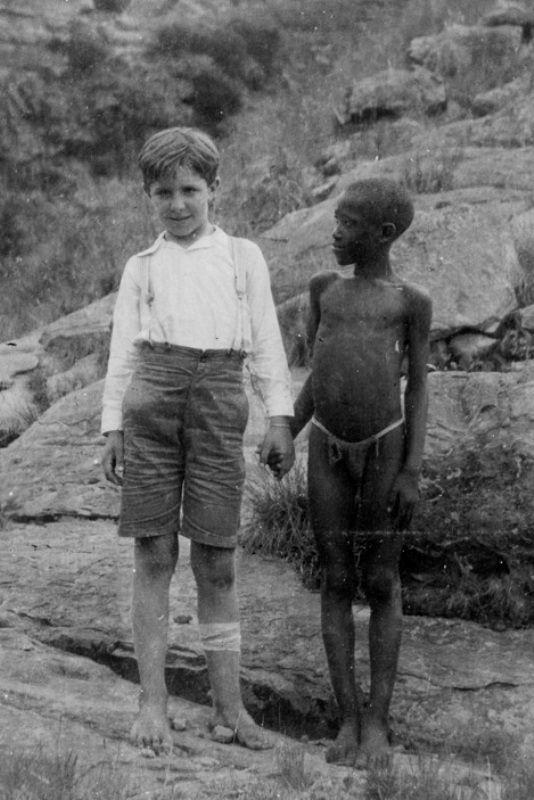
Christian Missionaries in Lesotho

Figure 1.--This French boy's family name is Verdier. He is show with a Lesotho friend. The Verdiers were a Reformed missionary family working at Lekhoele during the 1920s. The Lesotho boy is wearing a loincloth. The French boy is wearing short pants with suspenders and a long sleeves shirt. This was typical for French boys at the time. He is barefoot that was quite common for missionary kids, although they never would have gone shoeless in their homeland.
|
|
Traditional religions involved both animism and the veneration of ancestors. As in much of Sub-Saharn Africa, Christian missionaries began to reshape religious beliefs (early-19th century). We do not yet have a complete accounu of missionary work in Lesotho, but we have begun to collect some information. King Moshoeshoe invited the fitst missionaroies to Lesotho, primarily believing they would help obtain horses and modern weapons to repulse invaders (1833). Christian missionaries have since been very active in Lesotho. Most of the population is Christian (about 90 percent) with a small number of Muslims. The arrival of missionaries had many important consequences. They brought new crops, including potatoes, wheat, and fruit trees as well as domestic animals inclkuding cats and pigs. They also opened schools and began printing books in the Sesotho language.
First Missionaries (1830s-50s)
King Moshoeshoe was the son of a chief of the Bakoteli. This was a Basuto (Basotho) clan, a branch of the Koena (Crocodile) clan. The young Moshoeshoe helped his father gain power over some smaller clans. Moshoeshoe atvthe age of 34 years formed his own clan and became a chief. He and his followers settled at the Butha-Buthe mountain. The Basutho clans occupying the Mohokare valley encountered a threat from the south (1820s). Groups of Khoikhoi (the Kora) challenged the Basuto, They were led by Dutch-speaking people of mixed descent from the Afrikaaner areas. They included some mouted men armed with guns. The Basuto who did not yet have horses orfirearms. The Basuto took refuge on their mountain-tops and in remote rock-shelters, which negated the advantage of calvalry attack.
King Moshoeshoe saw that the Basuto needed to obtain horses and guns oftheir own. He had heard that vthere were advantages of having a resident missionary. Moshoeshoe provided cattle to induce a missionary to to come.
Moshoeshoe was not interested in Christianity, but he thought thata missionary might just help him obtain acess to guns so he could fight off the Kora raiders. Three missionaries from the Paris Evangelical Missionary Society (PEMS). France is a predominantly Catholic country, but these were Protesrant missionaries. They were Thomas Arbousset, Eugene Casalis and Constant Gosselin. They arrived in Thaba Bosiu (1833). Moshoeshoe placed them with his two senior sons (Letsie and Molapo) who they began to teach at Makhoarane. This is the site of modern-day Morija.
The arrival of missionaries had many important consequences far beyond obtaining guns and horses. . They brought new crops, including potatoes, wheat, and fruit trees as well as domestic animals inclkuding cats and pigs. They also opened schools and began printing books in the Sesotho language. The French missionaries had some advantages. They were neither English bor cDutch, the two groups of Europeans then colonising southern Africa. They were thus more easily accepted as citizens of Moshoeshoe's kingdom. Eugene Casalls even developed as an important adviser, a kind of Foreign Minister, for King Moshoeshoe in his dealings with bthe English abd Afrikaaners (1837-55). The built aission at the foot of Thaba Bosiu . Casalls' knowledge of the largely inknown outside world proved a great assett as white settlers began to move into the area and cthreaten his small kingdom.
Catholic Missionaries
We do not yet have details about Catholic missionary work in Lesotho. We do know that they played a major role in developin Lesoth's school system. Despite the fact that Lesotho was a poor country, it was remaravly developed at the time of independence.
Modern Missionaries
Various misionary groups are active in Lesotho today. This included denominations that do not yetbhave substantial numbers of adherents like the Bapstists. They describe their current activities, "The Baptist work in Lesotho is truly a team effort. On the front-lines are the IMB missionaries who work with the national pastors. Their work together is further strengthened by short-term volunteers from the USA and from South Africa. But behind all of this is the foundation of the prayer support of prayer warriors developed through the hard work of the Basotho Stateside Prayer Advocate. The work in " " ... planting new churches in the Lowlands of Lesotho as well as helping to disciple and train pastors and church members of existing Baptist churches."
The Church of the Nazarene entered Lesotho (1993).
HBC

Navigate the Boys' Historical Clothing Web Site:
[Introduction]
[Activities]
[Biographies]
[Chronology]
[Cloth and textiles]
[Clothing styles]
[Countries]
[Topics]
[Bibliographies]
[Contributions]
[FAQs]
[Glossaries]
[Images]
[Links]
[Registration]
[Tools]
[Boys' Clothing Home]
Navigate the Boys' Historical Clothing national pages:
[Return to the Main Lesotho page]
[Return to the Main African page]
[Algeria]
[Angola]
[Kenyan]
[Madagascar]
[Mali]
[South Africa]
[Uganda]
Created: 8:34 AM 5/27/2012
Last updated: 8:34 AM 5/27/2012



